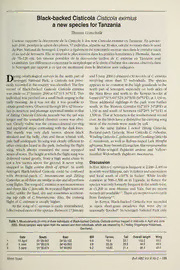Table Of ContentBlack-backed Cisticola Cisticola eximius
a new species forTanzania
Thomas Gottschalk
L’auteurrapporte la decouverte de la Cisticole a dos noir CisticolaeximiusenTanzanie. Enjanvier-
juin2000,pendantlasaisondespluies, 57individus,repartissur30sites,onteterecensesdanslenord
duParcNationalduSerengeti.L’especeaegalementeterencontreeentroissitesdanslecorridorouest
etausuddeSeronera. Ellesetrouvaitleplussouventdanslesprairiesluxuriantesa Themeda hautes
,
de 70-120 cm. Les raisons possibles de la decouverte tardive de C. eximius en Tanzanie sont
examinees. Lesdifferencesconcernantlamorphologieetlechoixd’habitatdesoiseauxobservesdans
le Serengeti par rapport a ce qui est mentionne dans la litterature sont indiquees.
D
uring ornithological surveys in the north part of and5June 2000Iobtainedc30recordsofC.eximius
Serengeti National Park, a Cisticola not previ- involving more than 57 individuals. The species
ouslyrecordedinthecountrywasidentified.Thefirst appears to be common in the highgrasslands inthe
record of Black-backed Cisticola Cisticola eximius north part of Serengeti, especially on both sides of
wasmadeon 17January2000at02°31'S34°51'E.This the Mara River and north to the Kenyan border at
individualwasperchedonasmallbushsinginginthe Lamai(01°3TS-01°32'S34o50'E-34°5TE), at 1,430m.
early morning. As it was not shy it was possible to Three additional sightings in the park were further
obtaingoodviews.Observedthrough10x42binocu- south, in the Western Corridor (02°l6'S 34°28'E) at
m
larsitsstructureandplumageappearedsimilartothat 1,330 and south of Seronera (02°28'S 34°5TE) at
ofZitting Cisticola Cisticolajuncidis but the tail was 1,590m. ThatatSeroneraisthesouthernmostrecord
longer and the unmarked chestnut crown was obvi- ever.Asthebirdshaveadistinctivefar-carryingsong
ous. Clearlyvisible was the cream-coloured eye-ring most ofthe records were made by call.
and supraloral stripe contrasting with the dark lores. In the same habitat I noted Zitting Cisticola,
The mantle was very dark brown, almost black Pectoral-patch Cisticola, Stout Cisticola C. robustus,
streaked and the belly, chin and throat whitish with WindingCisticolaC.galactotesandCroaking.Cisticola
pale buffunderparts. Its songwas clearlydifferentto C. natalensis, aswell as Rufous-naped LarkMirafra
othercisticolas heardinthe park, includingthe flight africana Rosy-breastedLongclawMacronyxameliae
,
song, which always contained the same repeated and White-winged Euplectes ardens and Yellow-
seriesofnotes.Theheightatwhichtheflightsongwas mantled Widowbirds Euplectes macrourus.
delivered varied greatly, from a high aerial cruise to
just a few metres above the ground. It never wing- Discussion
m
snapped in flight contra Birds ofAfrica2. In north InEastAfricaC.eximiusisfrequentat2,100-2,400
Serengeti Black-backed Cisticola could be confused innorth-westEthiopia,rareinEritreaanduncommon
with Pectoral-patch C. brunnescens and Zitting and local south of cl0°N in Sudan2 While locally
Cisticolas,asallthreearesimilarinsizeandallperform common at 900-1,500 m in Uganda,. in Kenya the
songflights.ThesongofC.eximiusisnotmonotonous specieswasonlyformerlyfrequentinthesouth-west,
andsharp,likeC.juncidis.Itsrepeatedflightnotesare at cl,200 m near Mumias and Yala, but no recent
softer, unlike the hard, dry and sometimes accelerat- recordsareavailable2’3.Therearenopreviousrecords
ing tsip calls of C. brunnescens. Also, the cruising from Tanzania1-3
.
flight ofC. eximius is usually higher. In Kenya, Black-backed Cisticola was recorded
As the song ofC. eximiusis easilyremembered, in open short-grass meadows that were dry or
Idiscoveredmoreofthespecies.Between17January seasonallyflooded3. In SerengetiNational Park only
Table1.Measurements(inmm)ofthreeindividualsofBlack-backedCisticolaCisticolaeximiustrappedin mist-netsinAprilandJune
2000. Bloodsamplesweretakenfromthesecondandthirdindividuals,whichareretainedbyAJ Helbig(VogelwarteHiddensee.
Germany).
Date South East Bill Tarsus Tail Overall length Wing
1 15April 01°29.947 34°50.122 9.0 18.6 33.7 103.5 49.0
2 3June 01°30.674 34°49.053 9.8 20.35 28.6 98.5 48.0
3 3June 01°30.674 34°49.053 9.2 18.85 31.4 98.5 48.0
ShortNotes BullABC Vol8No2-135
.
afewindividualswererecordedinshort-grassmead- age their tail lengths matched illustrations of non-
ows, which have recently been heavily grazed by breedingindividualsinUrbanetal1andZimmermann
ungulates. Insuchareassongwasalwaysgivenfrom etaP.
a perch. Most were observed in mid-height grasses, Additional research is required to determine if
c70-120 cm tall, occasionally on moist ground. The the small population of Black-backed Cisticola in
most widespread grass species were Themeda north Tanzania will persist, given that the principal
triandra, Sporobolusfimbriatusand Chlorisgayana. threat to the species’ habitat is man-made fire.
North ofthe Mara River Black-backed Cisticola also
uses 100-120 cm-high Themedagrasslandwithscat- Acknowledgements
tered Acacia (some up to 4 m tall). Small I thank the German Academic Exchange Service
open-grasslandpatcheswithinAcaciaparklandwere (DAAD) forfundingthe fieldworkandtheTanzania
also utilised. CommissionforScienceandTechnology(COSTECH),
As several records of Black-backed Cisticola Tanzania National Parks (TANAPA) and Tanzania
were made close to the Kenyan border the species Wildlife Research Institute (TAWIRI) for permission
may also be common in the southern Masai Mara, to work in Serengeti National Park. I gratefully
wherehabitatsappearsimilartothoseinTanzania. It acknowledge the assistance ofF M Chalamila in the
issurprisingthatsomanyrecordsofthespecieswere field and specially thank Barbara Hartmann for
made in the wet season in Serengeti, given the translating the French summary.
relativelackofpreviousrecordsfromTanzaniaorthe
Masai Mara. The records may result from a genuine References
expansionofthe species’ rangeormaybe indicative 1. Dowsett, R.J. and Dowsett-Lemaire, F. 1993. A
of the relative lack of attention most observers pay Contribution to theDistribution and Taxonomyof
cisticolas. Few ornithologists have visited the north- AfrotropicalandMalagasyBirds.TauracoResearch
ern Serengeti as the roads are sometimes very bad, Report 5. Liege: Tauraco Press.
especially during the wet season, and because of 2. Urban, E.K., Fry, C.H. and Keith, S. (eds) 1997. The
problems with poachers. BirdsofAfrica.Vol5.London,UK:AcademicPress.
Compared to the breeding males illustrated by 3. Zimmermann, D.A.,Turner, D.A. and Pearson, D.J.
1996.BirdsofKenyaandnorthern Tanzania. Lon-
Urban etal2 and Zimmermann et aP those seen in don, UK: A. & C. Black.
Serengeti National Park had noticeably longer tails.
Though the Serengeti birds were in breeding plum- BurgerstraJSe 2, 61476 Kronberg, Germany. E-mail:
thomasgottschalkMhotmail.com
The status of Isabelline Wheatear
Oenanthe isabellina in Morocco
ValerySchollaerf and Gilles Willemb
Cette note rapporte l’observation de neufTraquets isabelles Oenantheisabellinaau Maroc, entre les
13 et 17mars 2001. Ces donneesconfirmentla regularite, deja soupfonnee, de l'especedans le pays.
Cetraquetestvraisemblablementregulierenpetitnombre danslesud-estduMaroc, enfevrier-mars.
periode pendant laquelle un passage prenuptial important est constate en Algerie.
Between 13 and 17 March 2001, we birded arid Isabelline Wheatear is considered an accidental
areas of south-east Morocco, noting migrant visitortoMorocco1 the 19previous records concern
:
passerines such as Northern Wheatear Oenanthe individuals between 25Januaryand 26April, princi-
oenantheandWillowWarblerPhylloscopustrochilus. pallyinFebruary(six)andMarch(seven).Allbutfive
Formostspecies, itappears that individualswe saw records are from the south-east ofthe country, with
were among the firstto cross the Sahara thatspring. the others from West Saharan Morocco (P Bergier
The surprise was Isabelline Wheatear Oenanthe perscomm).Dufourny2 whodescribedtwoIsabelline
,
isabellina which we recorded on several occasions WheatearsseennearTouroug(westofErfoud),on16
with a tota,l ofnine individuals (see Appendix). We February 1993, considered the species as possibly
managed to take some photographs (see Fig 3) and regular as a spring migrant throughout south-east
all records have been submitted to the Moroccan Morocco. Indeed, more regular occurrence of
Rare Birds Committee. Isabelline Wheatear in Morocco during early spring
136-BullABC Vol8No2 ShortNotes

